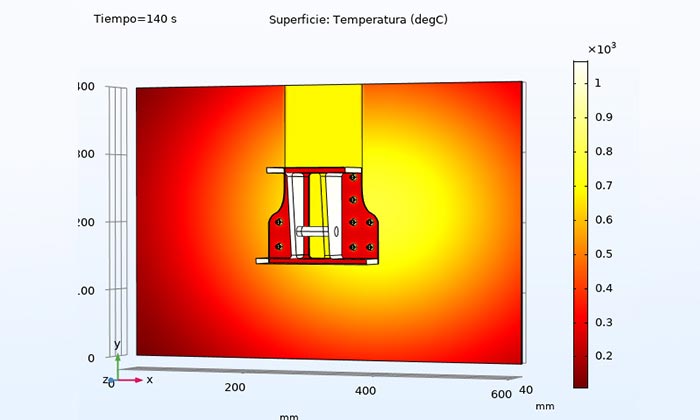New cutting-edge thermoplastic materials for the aerospace sector

New cutting-edge thermoplastic materials for the aerospace sector
Credit: UC3M
Results from the European HITCOMP project.
The Universidad Carlos III de Madrid (UC3M) coordinates the HITCOMP (High Temperature Characterisation and Modelling of Thermoplastic Composites) project within the Horizon 2020 programme, which aims to study the possible advantages of thermoplastic materials in the aerospace industry.
The European aerospace sector typically uses low-weight, high-performance thermosetting plastic composites—also known as epoxy resin based composites—in many applications. However, these materials are not as heat resistant as other metal aircraft components, which can compromise safety in situations where extreme temperatures are reached. In an effort to improve the current thermosetting composites’ behaviour in the face of heat damage, the HITCOMP research team has proposed an alternative: the use of new PAEK resins-based thermoplastic materials.
During the development of the HITCOMP project, components made from a thermoplastic base have been shown to be more efficient, from the perspective of their thermal properties, than thermosetting composites. A known property that makes them very useful is that they can be recast, reshaped, processed and recycled, without the need for any additional curing process in order to harden and set. In addition, they are more versatile, cheaper and eco-friendly materials than conventional thermosetting composites and have a longer service life, thanks to their high resilience —they can be recycled or repaired more easily— and fatigue resistance —wear and tear— and corrosion. The introduction of these materials would mean having safer and lighter aircraft which consume less fuel, improve energy efficiency and reduce their emissions.
To get the most out of thermoplastics in the aerospace industry, due to their capacity to melt and deform when overheated, it is necessary to determine their behaviour when subjected to heat, fire and mechanical loads. The HITCOMP project has developed a test laboratory with new infrared (IR) thermography techniques in order to obtain accurate and non-intrusive measurements of the actual temperature of materials during fire tests. The ultimate aim is to conduct virtual tests on thermoplastics and compare their performance in real applications with those of conventional thermosetting composites.
“The aerospace sector is undergoing a transition to a more electric aircraft. This involves more heat and eventually fire sources, increasing the heating effect on the structure”, explains Fernando López, lead researcher and coordinator of the HITCOMP project, from the UC3M Department of Physics. “In this context, our project aims to establish an innovative methodology which allows a characterisation of thermoplastics that involves fewer resources and improves the prediction of their behaviour and resistance when subjected to mechanical loads or fire and high temperatures.”
The measurements obtained by infrared thermography allow computer simulations to be carried out, which virtualize testing to select this type of material in the aeronautical industry. Its implementation is expected to “significantly reduce the number of validation tests, which are mandatory and greatly increase the cost and delay the approval of this type of material in the industry.” The IR models and equipment have already been transferred to the Airbus company so that it can study their industrial application.
During the research process, the team has also developed a new method —inspired by the previous results of UC3M’s Sensors, Remote Detection and Infrared Imaging Laboratory (LIR-InfraRed LAB)— which allows the use of these infrared imaging techniques to remotely determine the thermal properties of these materials, without contact.
The HITCOMP project has been funded by the Horizon 2020 programme as part of the 2020 call for proposals for Research and Innovation Actions (RIA), and is part of the 2019 European Union Clean Sky 2 announcement. Likewise, it is supported by the Spanish National Institute of Aerospace Technology (INTA, in its Spanish acronym), the high-tech IR company, Sensia Solutions and the Airbus Fire Lab.
Media Contact
Fco. Javier Alonso
Universidad Carlos III de Madrid
oic@uc3m.es
Office: 916249035
All latest news from the category: Materials Sciences
Materials management deals with the research, development, manufacturing and processing of raw and industrial materials. Key aspects here are biological and medical issues, which play an increasingly important role in this field.
innovations-report offers in-depth articles related to the development and application of materials and the structure and properties of new materials.
Newest articles

Innovative 3D printed scaffolds offer new hope for bone healing
Researchers at the Institute for Bioengineering of Catalonia have developed novel 3D printed PLA-CaP scaffolds that promote blood vessel formation, ensuring better healing and regeneration of bone tissue. Bone is…

The surprising role of gut infection in Alzheimer’s disease
ASU- and Banner Alzheimer’s Institute-led study implicates link between a common virus and the disease, which travels from the gut to the brain and may be a target for antiviral…

Molecular gardening: New enzymes discovered for protein modification pruning
How deubiquitinases USP53 and USP54 cleave long polyubiquitin chains and how the former is linked to liver disease in children. Deubiquitinases (DUBs) are enzymes used by cells to trim protein…



